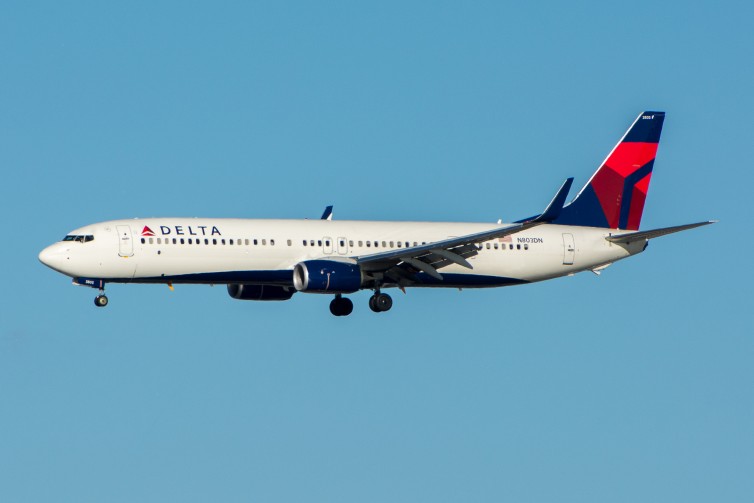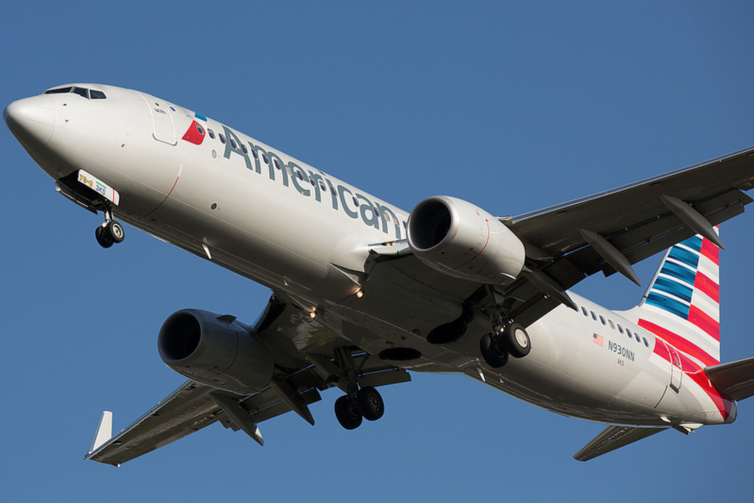
An American Airlines Boeing 737-800 – Photo: Jeremy Dwyer-Lindgren | JDLMultimedia
Recently, I had the chance to fly pretty similar flights from Seattle to Puerto Rico and back on Delta Air Lines and then American Airlines.
I had not flown on two domestic airlines back-to-back with so much the same, and I found there to be a pretty stark differences.
To San Juan, I took two Delta Boeing 737-900ERs with the newest interior (one was only a few weeks old). I flew from Seattle to Atlanta (shocking), then on to San Juan. On the way home, I took two American 737-800s. One had the Boeing Sky Interior cabin, but still shared entertainment screens. The second was an older 737-800, with no sky interior and also shared screens (but more on that later). I flew out of San Juan, through Miami, and then on to Seattle.
The cost of the tickets were exactly the same: $236 each way. I also earned Alaska Airlines miles for both flights, so I didn’t care about miles on either, nor did I have any status [update: I did not realize that Delta only gave me 50% Alaska miles vs American’s 100%. Still knowing this, it doesn’t change any of my choices or opinions since I am not much of a miles guy]. I was also in window seats and had similar seat-mate setups.
I went into these flights with no expectation of doing a story, but the fact that on similar flights, there was an obvious winner, I became motivated. And yes, you will have to wait until the end to see which airline won no cheating!

A model of an Up 737-800 – Photo: El Al/Up Airlines
Israel is not a large country. Because of this, domestic flying has never been of much importance. There are flights out of both Tel Aviv airports (TLV and SDV) to the resort town of Eilat, but even that is within driving distance. This fact has left Israel’s air travel market as one that focuses on flying to international destinations. Competition is heating up and El Al is planning to go head-on with a lower-cost version called Up.
Israel, though an extremely high-tech and growing economy, also has some market features that make it unique compared to equivalent countries in different climates. There is a gigantic Visiting Friends and Relatives (VFR) market. There is also a lot of business traffic traveling from Continental Europe on restrictive travel budgets. Realistically, most of the high-yield traffic comes from destinations in Northern Europe, North America, and Asia. British low-cost carrier easyJet is expanding its services to Tel Aviv at a seemingly unending rate. There is even talk of Easyjet competitor RyanAir starting Tel Aviv service this year.
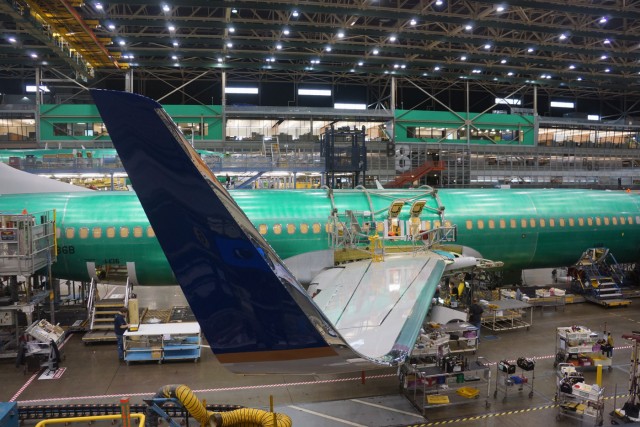
COPA Boeing 737 in the Renton Factory. Image by Chris Sloan.
This story was written by Chris Sloan and originally was published on Airchive.com. This is the next of a multi-part series talking about the Boeing 737 factory in Renton. Read the first part: A Historical Look at Boeing’s 737 Factory in Renton and second part: Inside Boeing’s 737 Renton Factory and the Successful Next Gen.
The Boeing 737 Goes Into ’œMAX’ Overdrive
The Boeing 737 NextGen order book continued to bulge, growing virtually unabated even through the deep worldwide economic slowdown / crisis of 2008-12. Ironically, this era of financial strife and sharply escalating fuel costs, as well as the growth of emerging markets, helped 737 and A320 sales go from strength to strength. Boeing however didn’t stand on it its laurels or did it?
Boeing claims with the introduction of its latest performance improvement package ’œPIP’, today’s NGs are 6-7 more efficient then when they were first introduced in the late 1990s. Boeing’s Tinseth points out that ’œThe (737) program has taken off with record sales. It’s simple. We make it better every time. We were first in its class with ETOPS 180, glass cockpits, Sky Interiors, and high bypass engines. We lower the operating costs through such new technologies as blended winglets, heads up display, carbon brakes, and more fuel-efficient engines. We enhance customer appeal with the new Sky Interior. This is an airplane that appeals to the heart of the market: emerging and developing economies and it is very successful with the LCC business model’. These new LCC airlines in emerging markets include Lion Air, Air Asia, and Gol! An unintended benefit of the weak economy, particularly in the U.S., is the poor financial results led to an elderly, fuel-in-efficient, maintenance intensive fleet which created an advantage and some say a bubble for airframe manufacturers, particularly in this sweet smart of the market. ’œThe significant driver in the US is the demand to replace older and less efficient aircraft’, said Tinseth.
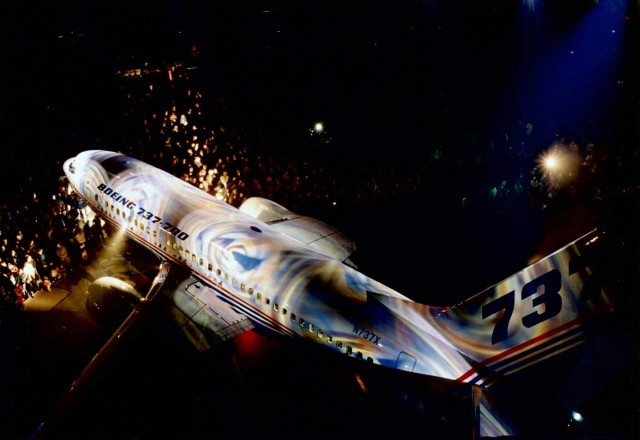
On December 2, 1996: The first 737NG, a 737-700, rolls out of the Renton factory to all splashy event. Image courtesy: Boeing
This story was written by Chris Sloan and originally was published on Airchive.com. This is the next of a multi-part series talking about the Boeing 737 factory in Renton. Read the first part: A Historical Look at Boeing’s 737 Factory in Renton.
Success Breeds Competition: The Airbus A320 ups the ante and Boeing is forced to answer
In 1988, the first serious competitor to the 737 monopoly, the Airbus A320 entered service. With even more advanced systems like fly-by-wire flight controls, new higher powered and fuel efficient engines, a wider cabin, the first major use of composite materials in a narrow body airliner, and somewhat larger capacity on a direct model comparison basis, the A320 family quickly became a force to be reckoned with. In addition, Airbus offered aggressive pricing and quicker delivery windows. Having only recently launched the 2nd generation 737s, Boeing didn’t respond to the European framer’s challenge for another 5 years.
In 1993, Boeing finally answered with the Boeing 737 Next Generation. First flying in 1997, it first entered service in 1998 as a 737-700 (comparable in size to the 737-300) for launch customer Southwest. While retaining commonality with the 2nd generation 737s, the NextGens included a redesigned wing, and eventually winglets, that increased total fuel capacity by 30% and range to over 3,000 miles. Quieter, more powerful and more fuel-efficient engines in the form of CFM56-7Bs came online as well.
In Part 1, I discussed what it was like from pre-delivery of RwandAir’s first Boeing 737-800 to taking off from Seattle. Part 2 will cover our adventures from lift off to a stop over in Iceland and Turkey. Here is Part 2:
The Boeing 737-800 normally has a range of about 3000 miles with an average load, but this was not an average flight. With only 30 people on board, the aircraft was much lighter which allowed us to fly over 3,600 miles non-stop from Boeing Field in Seattle, WA to Keflavik (KEF) just outside of Reykjavik, Iceland.
I had the entire 14th row to myself, and rows 13 and 15 were totally empty. I felt like a king sitting in economy, which doesn’t happen too often. Though I had ample space, there were some disadvantages to sitting in the back of the plane was the in-flight entertainment system. Business Class passengers got their own in-seat entertainment system, but it is all about sharing in the rear. After we took off and leveled out, the movie Cedar Rapids started playing, but I opted for a nap instead. I knew I wouldn’t have too much time to sleep since we were racing against the sun. Even though we took off at about 5:30pm, we were going to land in Iceland after it would be dark a little under seven hours later.
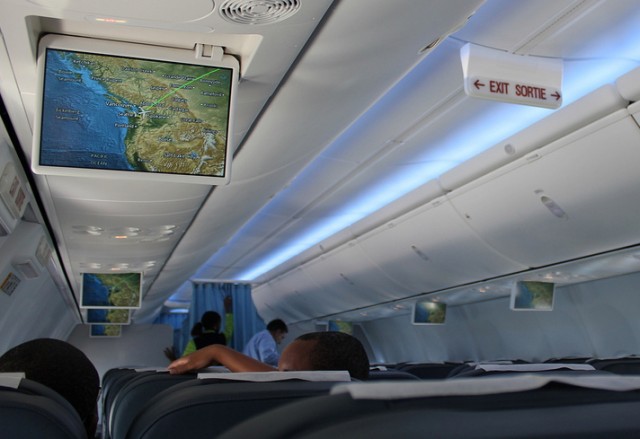
The in-flight map shows we just left Seattle. We have a long trip ahead of us.
Even with an entire row to myself, it still was not easy getting comfortable as a 6’1″, 250lb person. Still, I managed to sleep a few hours lying down and a few hours while sitting up. When I awoke, it was time to eat our first meal. Before the flight, food service was loaded onto the aircraft, and I was looking forward to (eh, more afraid of) what it might be. Fortunately, the food was better than your standard economy fare, consisting of a decent steak and shrimp.
At first, the service on the flight was a bit strange. Although there were only about 30 people on the aircraft, the flight attendants provided separate levels of service for business versus economy. I have been on a few VIP flights with a smaller number of passengers and service was the same in the front and back. At the start of this trip, the front got hot towels, champagne and first class service. Not that we were hurting in the back, but I wanted my hot towels and extra drinks (how spoiled I have become). It turns out the cabin crew just never thought about it was initiating the standard level of service they regularly complete. From Iceland on, the divider curtain was not shut and everyone received the same high level of service.
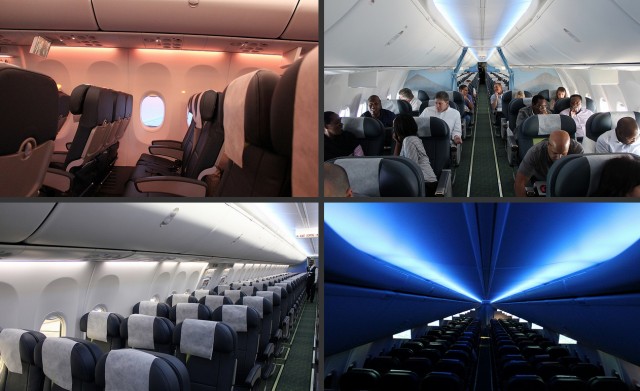
Some of the different flavors that Boeing's Sky Interior can produce. Upper left is meal service and bottom right is sleep. The others are standard operating settings.
Most passengers might not realize they are on a 737 with the new Sky Interior. But they should notice how modern and roomy the plane feels. After catching a ride on American Airline’s first Sky Interior 737 and now after about 20 hours in RwandAir’s, I can truly say I love it. It is not revolutionary, but a very smart evolution to the 737.
There are optical illusions and actual changes that make the cabin seem larger. The windows now have a round surround and updated paneling on the walls. The ceiling has color-changing LEDs and the standard setting is a nice blue, which makes the cabin feel taller. The overhead bins have been re-designed to be opened and closed more easily, while providing more head space for passengers. As of now, the Sky Interior is an option for airline customers and about 88% of airlines are opting for the new interior. Boeing has announced that all 737 MAX aircraft will come with the Sky Interior standard.
Because this was a longer flight, I was able to see a larger array of lighting choices. Airlines are able to choose different light settings for different parts of the flight: blue for boarding, white before landing, an orange while eating and maybe a deep blue for sleeping. But by the time we were getting close to Iceland, it was already quite light outside.
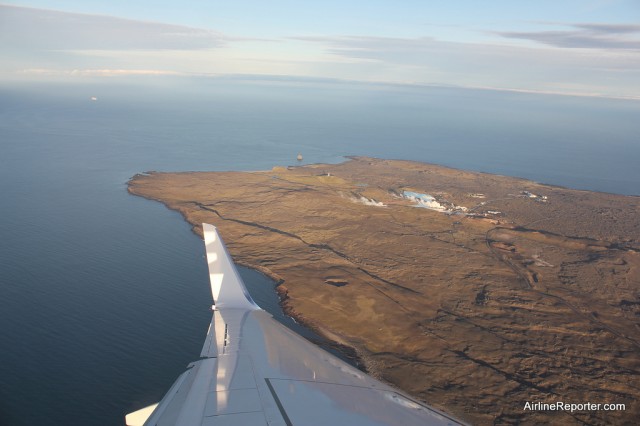
Coming into Iceland is quite bare. I wasn't sure we were actually landing at a main airport, but it was.
When finally breaking through the clouds outside of Iceland, I assumed it was going to be a while until we hit the airport since there was nothing but land in sight. Sure enough, the airport was in the middle of nowhere. When landing, I was hoping for some pretty heavy cross wind normally found at the airport, but on this cold morning there were only a few gusts. The airport is great if you love Icelandair Boeing 757s, since there were quite a few. We ended up parking next to the cargo loading area and waited to be fueled. We were allowed to leave the plane and hang out on the tarmac and even though it was nippy, I opted to spend almost the whole time out there.
After being fueled up and loaded back in, I noticed the special Iron Maiden livery Boeing 757 was behind us, providing a nice treat. Even the non-airline nerds on the plane found the livery interesting. Then was were back in the sky, heading south to Istanbul, Turkey.
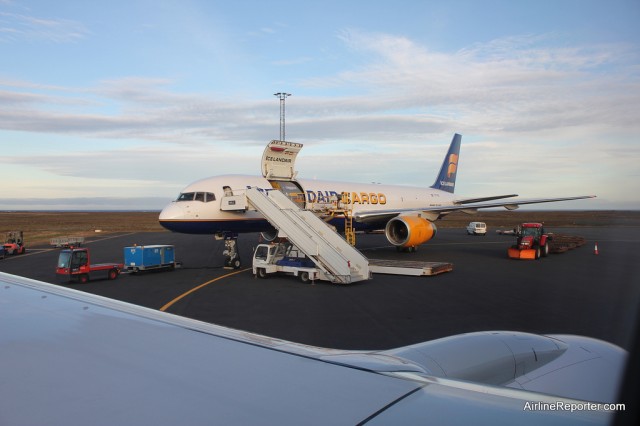
An Icelandair Cargo Boeing 757 looks on while we wait to be fueled. Lots of nothingness in the background.
We were supposed to land at Atatà¼rk International Airport (IST), but our late arrival meant, there were not any slots available during our new landing time. We landed instead at the much smaller Sabiha Gà¶kçen International Airport (SAW), which operates low cost carriers like Pegasus Airlines. This wasn’t a bad thing, since it allowed us to deplane on the tarmac, giving better photo opportunities.
After clearing through customs, we had a van waiting to take us to Divan Hotel. It was about 8pm local time when we arrived, but I knew I did not just want to eat and go to sleep. First things first; it was time to take a nice long cool shower and then prepare for a night-time adventure.
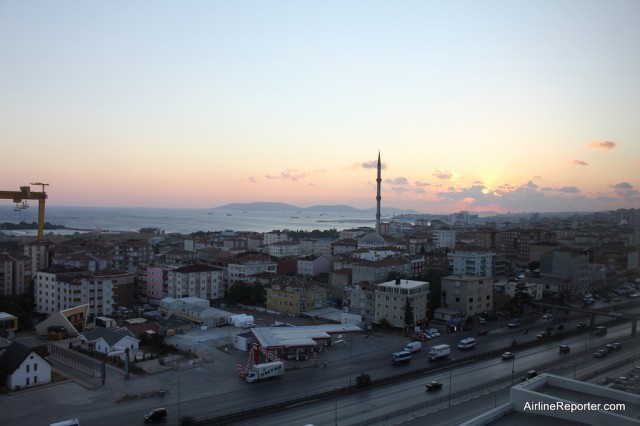
Not too shabby. View from my hotel room while in Istanbul, Turkey.
After cleaning up, most of our group met on the rooftop bar of the hotel. When I first arrived there were only four people including RwandAir’s CEO John Mirenge. He welcomed me to the table and offered food and drink and I asked him what it felt like to see his brand new plane for the first time. He stopped and it was obvious he was emotionally affected. It was not only about buying a new plane, but it was about being able to take the plane back to Rwanda. I have never seen an airline executive so connected to one of his aircraft — it was quite powerful.
After talking about airplanes, it was time to relax and have some local Efes Beer and some food. Even though it was late, most of us decided to head out into town. I was told we were on the Asian side of town, but there is also the European side of town as well. We got three cabs and honestly I have no idea where we went, but I was just along for the ride. After some coffee we decided to get some “adult” drinks and ended up at a bar called “The Sheriff” that was Old West themed. It took us a while to realize we had just flown half way around the world to go to a western bar — oh well. We were quite surprised that it happened to be so dead around midnight on a Friday. We asked some locals and learned it was Ramadan. Religious natives were not going out, which I can understand, but it made the night life more like a mid-week evening life.
After hanging out for a while, it was time to take a cab back to the hotel. Driving in Istanbul seems like every man for himself. At intersections, people do not yield and speed is the name of the game. During the taxi ride home I sat in the front seat and my belt did not work — it was quite the hairy ride. The driver had a hard time finding his way back to the hotel, and just decided to stop in the middle of the freeway where he pointed to stairs across the road that we could take. Obviously hospitality was not a concern of his.
It is difficult to judge an entire city by just spending 14 hours there, so I would love to return with some additional time and maybe a better taxi driver.
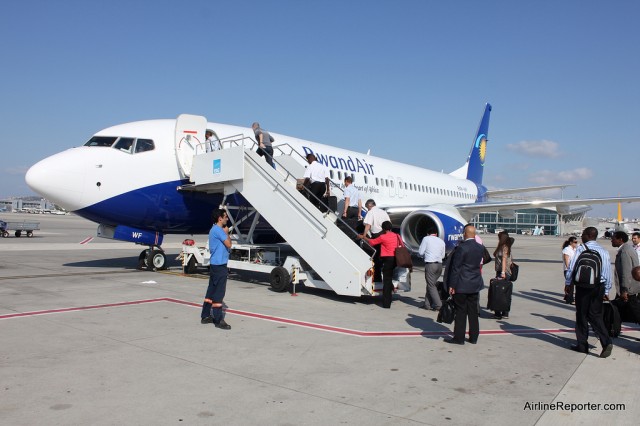
Loading back on the plane in Istanbul, getting ready to fly to Kigali, Rwanda.
After a short rest, we met up in the lobby of the hotel ready to continue our journey to Kigali. While heading back through the airport customs, the security official was shocked when he saw my boarding pass said “Kigali.” Because of a minor language barrier, it took me a while to realize he wasn’t questioning me for security purposes, but because of his own interest in the boarding passes he sees.
The RwandAir 737 was right where we left it. We quickly re-boarded and I decided to take a seat a bit closer to the front of the engines for better photos while landing. I already had quite a few assumptions about what Rwanda was going to be like and I was about to find out how wrong I was. We had about a five and a half hour flight down south and we heard we had quite a celebration waiting for us at our destination. I buckled up, sat back and was ready for the real adventure to begin.
RWANDAIR BOEING 737-700 DELIVERY FLIGHT
Part 1 | Part 2 | Part 3 | Video | 737 Photos | Rwanda Photos | Destination Story | All

